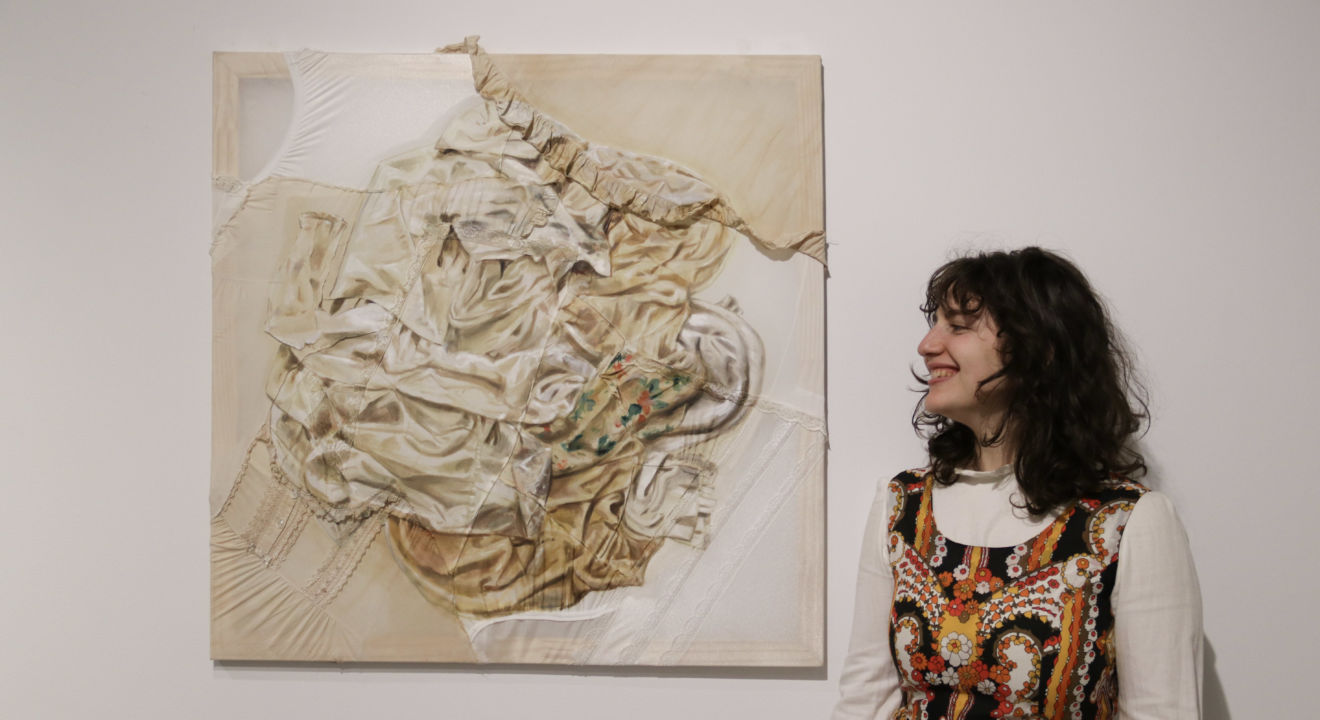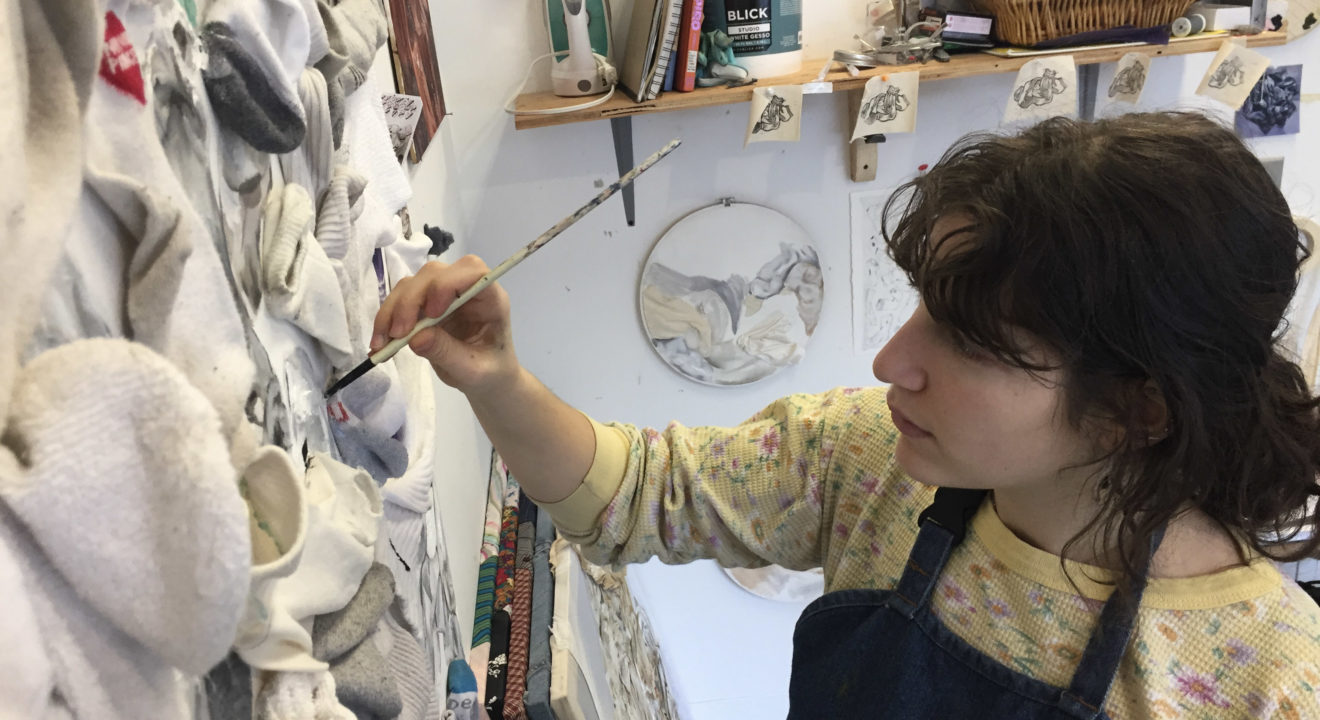Sustainability December 21, 2018


Sydney Hunter Kleinrock is an artistic polymath. She is a painter, illustrator, printmaker, zine-maker, fashion designer and textile artist. An alumna of the Fashion Institute of Technology, Sydney loves clothing – the way garments feel on the body, the way they influence how we present ourselves to the world, the playfulness they can inspire. One thing she doesn’t love, however, is the trail of pollution they leave in their wake. Not to mention, the way that discarded shirts, trousers, and last-season’s-must-haves are piling up in our landfills. Overconsumption and materialism galvanize Sydney’s artistic vision as she explores the external and internal burden of simply having too much stuff. Collecting jettisoned clothing, Sydney transforms rubbish into protest. Her work is “an examination of the threads between our clothing and the environment.” I spoke with Sydney to better understand how her perspective on both fashion and the environment informs her art, and to learn how she hopes to engage her generation in lessening its fashion-footprint.
I have been interested in fashion ever since I can remember. My mom was never the biggest shopper, so I sort of compensated for that by drawing photos of clothing that I imagined myself wearing. When I got a little older I read a lot of Teen Vogue and kept up with other major fashion blogs. I see clothing as an art form, and I loved combining different pieces together to express who I wanted to be that day.
I think art as activism is crucial because it is digestible. It initially brings people in with surface-level aesthetics and then can take their thoughts to a much deeper place that they may not have gone to without it. A lot of people can be turned off by heavy facts and news articles, but art can make things more personal and relatable. All kinds of activism play a role in creating change, but art as activism intends to produce an emotional response from the viewer that they will carry with them as they continue to make choices in their life.
Yes! I have loved to draw since I was a little kid. I have always sought out creative expression in some form over the years, be it through clothing design, drawing, painting, embroidery, photography or even cooking.
Many of the major issues in our world surrounding climate and environmental change are rooted in racism, sexism, colonialism, and capitalism and Hampshire helped me to examine that with a critical eye. I was also able to take art classes that gave me the freedom to translate my feelings and reflections into tangible works of art that challenged me creatively and conceptually. Being granted an excellent studio space, I was able to work through ideas and produce whatever work I wanted!


I think we need to examine the reasons why we own and continue to buy so many things. Obviously the first step is to buy less stuff! Being mindful when we go out shopping is a great way to lessen the demand for things. It is important to be a conscious consumer in all the ways that we can when we do need to buy things. Although buying from sustainable brands may not be accessible to everyone, if you do have the resources it is important to support companies that are trying to do good. On a larger scale, it is important to talk to people around you, and vote officials into office that are making changes that align with the direction you want the world to go in.
I hope that the layered components of my pieces urge people to think about the complexities of the fashion world and what their place is in it. I don’t expect everyone to drastically change their lifestyles after viewing my work, but my intention is that it will prompt people to look a little deeper into their own habits and possibly change some for the better! I also hope my art translates a sense of universality and community. Many of us have the same issues with our wardrobe and I try to demonstrate that in my work.
I try not to buy clothing as much these days. I like to acquire items from the community around like friends and clothing swaps. If I am going shopping, my first choice will always be thrift stores. It makes the most sense for me to give an item that already exists a second life than to create a demand for new clothing where there is already so much out there. For the few items that I do by new, I do my best to shop at ethical brands that are trying to counteract the damage that has been done to the environment.
I am very optimistic for my future. I really enjoyed this past exhibition and I am excited to continue creating outside of an academic setting. I’m looking forward to travelling and learning more about the world, as well as seeking out new opportunities that will help me grow as an artist and human! I would love to be able to continue working in a way that I get to be creative while helping the world around me.
Millennials and Gen Z are doing great work already with waking people up to climate change. Now more than ever I have noticed younger people getting together and speaking up for the planet. I think continuing to organize, protest, and educate those around them through whatever means necessary are all great steps to spreading the message.
I have so many different favorites, as these things are where I draw a lot of my inspiration from. I read “Mindfulness in Plain English” by Henepola Gunaratana over the summer, it is sort of a how-to guide on meditation and living mindfully, and I really enjoyed how easily I could implement it into my life. “Call Me By Your Name” is my favorite movie that I have seen this past year. It touched me in a way that hasn’t happened with a film in a very long time, and the colors and scenery are magnificent! I have stepped away from keeping up with designers more recently, but I will always appreciate Rei Kawakubo’s work! I have taken a lot of inspiration from Lauren Luloffs textile paintings this semester, and Salvador Dali would be an ongoing favorite for the playfulness in his work.
I would love for my art to influence people to look further into themselves and as a result, base more of their actions on love rather than fear. I also hope that my work can make people feel more empathetic towards others and can help demonstrate the connectedness between all of us. Lastly, I hope that I can instill a deep respect for the humans, creatures and environment around us that shape our world today.
There is a documentary called The True Cost that does a great job at exposing the fast fashion industry. I highly recommend everyone watch it, because it is truly eye opening. Besides that, it is important to research and look into the companies that you buy clothing from. There are tons of resources online these days that can help you decide if a company is ethically just. Buying less things and buying things secondhand is the most impactful way to lessen your carbon footprint. Alternatively, looking for sustainable brands that use natural fibers, zero waste cutting methods, recycled fabrics to construct their garments. In terms of everyday wear, washing and drying our clothing is pretty taxing on our environment. By wearing clothing more than once, spot cleaning, and hanging to dry when you can really make a difference! Another tip is learning to repair your own clothing when there is a hole. It can be very rewarding and save a garment from a life in the landfill! Lastly, when disposing of clothing, first opt for clothing swaps or consignment shops, and if the clothing is too damaged to be worn, take it to a fabric recycling facility.